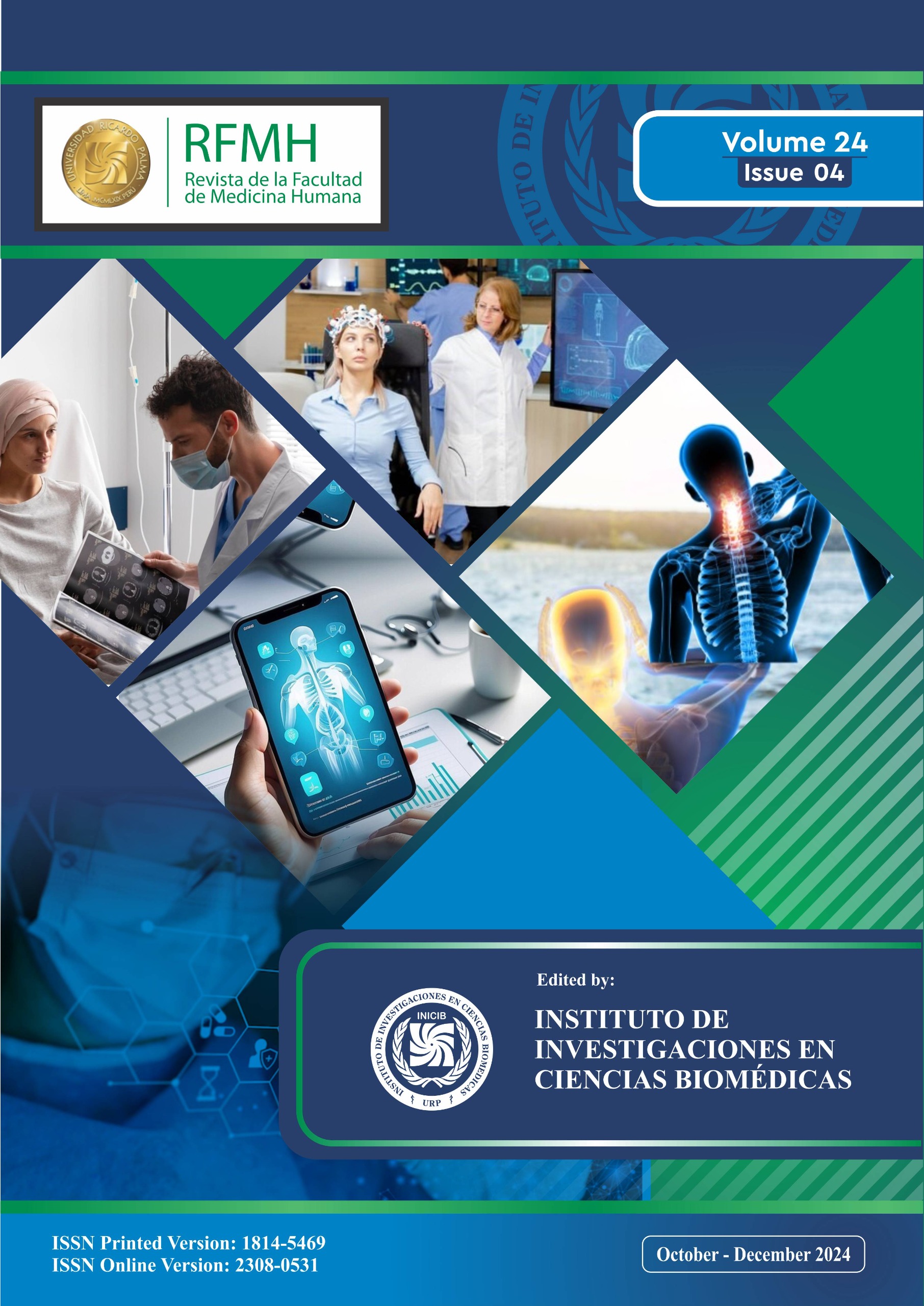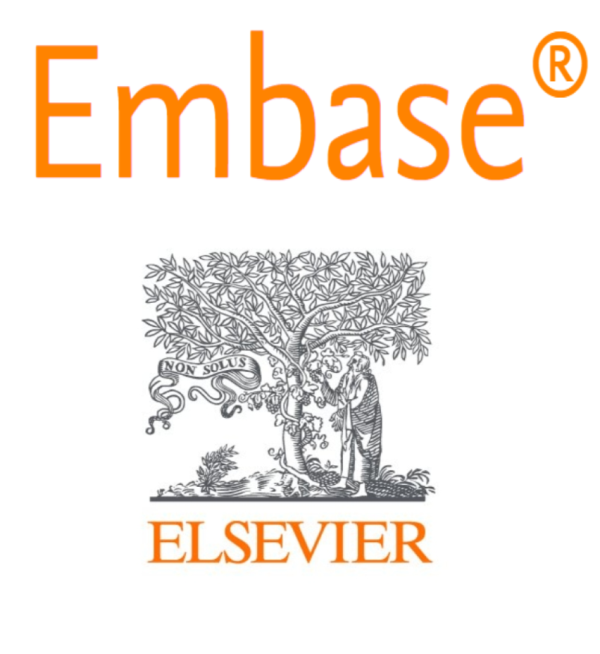FACTORS ASSOCIATED WITH EMERGENCE DELIRIUM IN PEDIATRIC PATIENTS IN PERU: RESULTS OF A CROSS-SECTIONAL STUDY
FACTORES ASOCIADOS CON EL DELIRIO DE EMERGENCIA EN PACIENTES PEDIÁTRICOS EN PERÚ: RESULTADOS DE UN ESTUDIO TRANSVERSAL
DOI:
https://doi.org/10.25176/RFMH.v23i4.5897Keywords:
Emergence delirium, anesthesia, children, palliative careAbstract
Objetivos: Identificar factores asociados al delirio de emergencia en niños de la Unidad de Recuperación Postanestésica de un Instituto Especializado en Salud Pediátrica del Perú. Métodos: Se realizó un estudio transversal en niños de 2 a 6 años, estado físico clasificación I y II, en procedimientos electivos bajo anestesia. La variable principal fue la presencia de delirio de emergencia evaluado con la escala Pediatric Anesthesia Emergence Delirium mayor o igual a 10 puntos. Para identificar los factores asociados al delirio se aplicó el modelo de regresión de Poisson y se consideró significativo un valor de p < 0,05. Resultados:De los 150 niños, se encontró que la incidencia de delirio de emergencia ocurrió en el 10,6%. De estos, el 81,4% eran menores de 5 años, el dolor se asoció significativamente en el 37,5% con RP = 3,63, IC95% [1,20, 10,1] y se observó que el 68,8% requirió cuidados paliativos. Conclusiones: El dolor se asoció con el delirio de emergencia postanestésico en niños. La prevención y el tratamiento del delirio de emergencia deben centrarse en el control del dolor posoperatorio y la monitorización cuidadosa de los pacientes después de la cirugía.
Palabras clave: Delirio de emergencia, anestesia, niños, cuidados paliativos (Fuente: DeSH).
Downloads
References
Sikich N, Lerman J. Development and psychometric evaluation of the pediatric anesthesia emergence delirium scale. Anesthesiology. 2004;100(5):1138-45. DOI: 10.1097/00000542-200405000-00015
Barreto ACTP, Rangel da Rocha Paschoal AC, Barbosa Farias C, Gomes Nogueira Borges PS, Gonelli Albanez da Cunha Andrade R, de Orange FA. Fatores de risco associados a delírio no despertar da anestesia em crianças submetidas à cirurgia ambulatorial [Risk factors associated with anesthesia emergence delirium in children undergoing outpatient surgery]. Braz J Anesthesiol. 2018; 68(2), 162–167. DOI: https://doi.org/10.1016/j.bjan.2017.11.002
Menser C, Smith H. Emergence Agitation and Delirium: Considerations for Epidemiology and Routine Monitoring in Pediatric Patients. Local Reg Anesth. 2020;13:73-83. DOI: https://doi.org/10.2147/LRA.S181459
González-Cardenas VH, Munar-González FD, Pinzón-Villazon IL, Cabarique-Serrano SH, Burbano-Paredes CC, Cháves-Rojas N, et al. Study of paediatric postoperative delirium and acute pain in low surgical risk procedures. Rev Colomb Anestesiol. 2018; 46(2):126-33. DOI: 10.1097/CJ9.0000000000000024
Gooden R, Tennant I, James B, Augier R, Crawford-Sykes A, Ehikhametalor K, et al. Incidência de delírio ao despertar e fatores de risco após o uso de sevoflurano em pacientes pediátricos para cirurgia ambulatorial, Kingston, Jamaica [The incidence of emergence delirium and risk factors following sevoflurane use in pediatric patients for day case surgery, Kingston, Jamaica]. Rev Bras Anestesiol. 2014;64(6):413-8. DOI: 10.1016/j.bjan.2013.09.011
Iturralde-Gamboa GN, Morales-Zapata IV. Incidencia y factores de riesgo para agitación al despertar en pacientes pediátricos sometidos a anestesia general en cirugía programada en el Hospital Pediátrico Baca Ortiz, 2018-2019 [Incidence and risk factors for emergence agitation in pediatric patients undergoing general anesthesia for scheduled surgery at the Baca Ortiz Pediatric Hospital, 2018-2019] [Thesis for Anesthesiology, Resuscitation, and Pain Therapy specialist]. Quito: School of Medicine, Pontificia Universidad Católica del Ecuador; 2019.
Marín-Toledo IA, GonzálezdelPino-Ruz I, Ramírez-Fernández JA. Caracterización de los episodios de agitación durante la emergencia de la anestesia general en pediatría [Characterization of agitation episodes during the emergence from general anesthesia in Pediatrics]. Rev Medica Electron. 2019;41(2), 397–409.
Cole JW, Murray DJ, McAllister JD, Hirshberg GE. Emergence behaviour in children: defining the incidence of excitement and agitation following anaesthesia. Paediatr Anaesth. 2002;12(5):442-7. DOI: 10.1046/j.1460-9592.2002.00868.x.
Banchs RJ, Lerman J. Preoperative anxiety management, emergence delirium, and postoperative behavior. Anesthesiol Clin. 2014; 32(1):1-23. DOI: 10.1016/j.anclin.2013.10.011
Lin N, Liu K, Feng J, Chen R, Ying Y, Lv D, et al. Development and validation of a postoperative delirium prediction model for pediatric patients. Medicine (Baltimore).2021; 100(20): e25894. DOI: 10.1097/MD.0000000000025894
Kramer S, Krebs M, Spies C, Ghamari S, Höhne C, Becke K, et al. Drama im Aufwachraum: pädiatrisches Emergence-Delir. Anasthesiol Intensivmed Notfallmed Schmerzther. 2018;53(11/12):766–76. DOI: 10.1055/a-0575-0473
Lee C. Paediatric Emergence Delirium: An Approach to Diagnosis and Management in the Postanaesthesia Care Unit. J Perioper Crit Intensive Care Nurs, 2017;3:2. DOI: 10.4172/2471-9870.10000140
Locatelli BG, Ingelmo PM, Emre S, Meroni V, Minardi C, Frawley G, et al. Emergence delirium in children: a comparison of sevoflurane and desflurane anesthesia using the Paediatric Anesthesia Emergence Delirium scale. Paediatr Anaesth [Internet]. 2013;23(4):301–8. DOI: 10.1111/pan.12038
Nair S, Wolf A. Emergence delirium after paediatric anaesthesia: new strategies in avoidance and treatment. BJA Educ, 2018;18(1):30–3. DOI: 10.1016/j.bjae.2017.07.001
Crellin D, Harrison D, Santamaria N, Babl FE. Comparison of the Psychometric Properties of the FLACC Scale, the MBPS and the Observer Applied Visual Analogue Scale Used to Assess Procedural Pain. J Pain Res. 2021;14:881-92. DOI: 10.2147/JPR.S267839
Merkel SI, Voepel-Lewis T, Shayevitz JR, Malviya S. The FLACC: a behavioral scale for scoring postoperative pain in young children. Pediatr Nurs. 1997;23(3):293–7.
Shin S, Evans F, Mason K. Emergence Delirium in Pediatric Patients [internet]. England: World Federation of Societies of Anaesthesiologists (WFSA); [Cited 2023 May 23] Avaible from: https://resources.wfsahq.org/atotw/emergence-delirium-in-pediatric-patients/
Houben A, Ghamari S, Fischer A, Neumann C, Baehner T, Ellerkmann RK. Pediatric emergence delirium is linked to increased early postoperative negative behavior within two weeks after adenoidectomy: an observational study. Braz J Anesthesiol.2021;S0104-0014(21)00138-X. DOI: 10.1016/j.bjane.2021.03.008
Doerrfuss JI, Kramer S, Tafelski S, Spies CD, Wernecke KD, Nachtigall I. Frequency, predictive factors and therapy of emergence delirium: data from a large observational clinical trial in a broad spectrum of postoperative pediatric patients. Minerva Anestesiol.2019;85(6):617-24. DOI: 10.23736/S0375-9393.19.13038-6
Eccleston C, Fisher E, Howard RF, Slater R, Forgeron P, Palermo TM, et al. Delivering transformative action in paediatric pain: a Lancet Child & Adolescent Health Commission. Lancet Child Adolesc Health.2021;5(1):47-87. DOI: 10.1016/S2352-4642(20)30277-7
Somaini M, Engelhardt T, Fumagalli R, Ingelmo PM. Emergence delirium or pain after anaesthesia--how to distinguish between the two in young children: a retrospective analysis of observational studies. Br J Anaesth. 2016;116(3):377-83. DOI: 10.1093/bja/aev552.
Downing J, Jassal SS, Mathews L, Brits H, Friedrichsdorf SJ. Pediatric pain management in palliative care. Pain Manag. 2015;5(1):23-35. DOI: 10.2217/pmt.14.45

Downloads
Published
How to Cite
Issue
Section
License
Copyright (c) 2023 Revista de la Facultad de Medicina Humana

This work is licensed under a Creative Commons Attribution 4.0 International License.






























